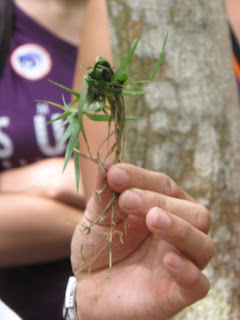Tunnels and their entrances were just large enough for slim, often malnourished, Vietnamese to crawl through. In fact, creating tight spaces was a defensive measure in that enemy forces were often simply too large to physically maneuver. Not to say there were a lot of attempts because entrances were well camouflaged.
It is amazing to hear reports on these fully-functioning tunnels, complete with areas for communication, supply routes, hospitals, food storage, weapon caches and living quarters for some 60,000 Vietnamese. It is an understatement to say the tunnel system was of great importance to the Viet Cong in their resistance to American forces. I heard that America lost 95% of their troops in this area because of enemy use of tunnels.
Aside from the vast amount of detail we heard about the war and tunnels, I found our guide's comments on the Vietnamese perspective most revealing: "The Vietnamese assumed the Americans and allies wanted to take control of their country as had the Chinese (who occupied Vietnam for 1000 years), the French (100 years) and Japanese (1 year). Most Vietnamese, therefore, considered the Americans the enemy and fought them for the duration." Our guide suggested things would have been different if the local population knew the fight was actually against the ideology of communism and not to take possession of their country.
The Viet Cong did not only play defense but offense. The last person to go into a tunnel would close the entrance and hang a bomb on the inside cover. If a foreigner found and opened the entrance cover, they typically wouldn't live to talk about it.
There were also traps for unsuspecting soldiers, such as camouflaged punji stake pits with poisoned spikes at the bottom. Unsuspecting soldiers would walk through the jungle and suddenly fall into these pits. If the spikes didn't kill the falling soldier then the poison would. American forces retaliated by trying to force the enemy out of the tunnels via flooding, bombing, dogs, etc. Only hand-picked teams of specially trained US soldiers, referred to as tunnel rats, had a reasonable chance of actually entering the tunnels and emerging alive.
The Vietnamese had some 30 years to perfect the art of living underground. Our tour guide explained their ways of survival, including:
- cooking underground by filtering smoke through the soil, so the enemy would not see smoke rising from chimneys and know their location
- identifying tunnel entrances via twig markers (see photo)
- evading dogs sniffing them out by placing chili spices or leftover soap Americans used for showering around tunnel entrances; the dogs either lost their sense of smell from the chili or assumed Americans had been there because of the soap smell
- depositing soil removed from the tunnel by filling nearby bomb crevices
- reusing everything left by their enemy such as rubber tires, soap, string from parachutes, and ammunition to name a few
- dealing with human waste in special underground areas; again there couldn't be any sign of civilization in the jungle or the Americans would know their location
- digging 3 levels of tunnel all by hand; if the top level caved due to a bomb attack, for instance, then the Vietnamese could escape through lower levels
- creating ventilation via hollow bamboo shoots that were eventually eaten by termites and ended up looking like termite mounds
Tourists were allowed to crawl our way through 100m of the tunnel if we wanted. I chose to go through 20m of it before looking for the first glimpse of daylight, which meant an exit. Even though the tunnels were expanded for tourists, we got a good idea of what the space was like underground: dark, tight, disorienting and hot! Definitely not for the claustrophobic.
I really don't know how the Vietnamese lived underground for 20 years, seldom seeing daylight and only coming out at night to scavenge for supplies. I guess war drives people to do whatever it takes to survive. The author of a Washington Post article says it best, "The tunnels are a powerful universal testament to the strength of the human will against overwhelming odds."





